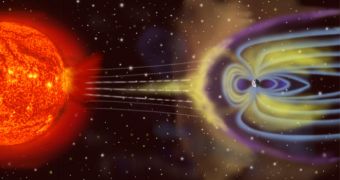A new research performed by a team of specialists led by Charles Chappell, research professor of physics and director of the Dyer Observatory at Vanderbilt University, collected and analyzed the data resulted from the observations of five different satellites. The data were related to the composition and behavior of the magnetosphere, and allowed the group of scientists to discover the existence of a previously undetected layer.
The magnetosphere is the unseen shield comprised of electrically charged particles roaming along the pathways imposed by magnetic fields, which protects our planet from the constant celestial bombardment of cosmic rays, solar winds and the likes, causing events like the auroras in the process. Chappell and his colleagues were able to identify the presence of a new zone of the magnetosphere, a warm plasma cloak, using a computer simulation of the behavior of low-energy ions originating from the atmosphere, as they reached different parts of the magnetosphere.
The thin cloak spans for about three quarters of the planetary surface, starting from the night side, crossing to the day side and fading into the afternoon side, and it is fueled by low-energy charged particles. The computer model predicting the motion patterns of the bouncing and drifting ions spiraling through the magnetic field, developed by Dominique Delcourt from the French Centre d'etude des Environments Terrestre et Planetaires, Observatoire de Saint-Maur, was a key part of the study.
"We have recognized all the other regions for a long time, but the plasma cloak was a fuzzy thing in the background which we didn't have enough information about to make it stand out. When we got enough pieces, there it was!" shared Chappell, as cited by PhysOrg.
"Although it is invisible, the magnetosphere has an impact on our everyday lives," he explained. "For example, solar storms agitate the magnetosphere in ways that can induce power surges in the electrical grid that trigger black outs, interfere with radio transmissions and mess up GPS signals. Charged particles in the magnetosphere can also damage the electronics in satellites and affect the temperature and motion of the upper atmosphere."

 14 DAY TRIAL //
14 DAY TRIAL //